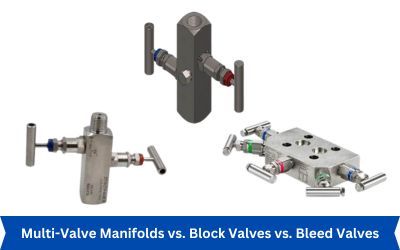Fluid control systems depend on the proper selection of valve types to ensure smooth operations, efficient control, and safety. Multi-valve manifolds, block valves, and bleed valves each play a crucial role in system functionality, particularly in isolation, venting, and pressure regulation across various industrial environments. Whether you're managing a complex oil and gas system or maintaining an HVAC setup, understanding the differences between these valve types can help you make better decisions for optimal performance. In this guide, we’ll explore the distinctions between multi-valve manifolds, block valves, and bleed valves, and how they contribute to the efficiency and reliability of your fluid control system.
Understanding the Basics of Multi-Valve Manifolds, Block Valves, and Bleed Valves
Each type of valve serves a unique purpose in fluid control systems. Here’s a closer look at their functions:
-
Multi-Valve Manifolds:
Multi-valve manifolds, also known as manifold valves, are designed for systems that require multiple lines or intricate flow management. These units integrate several valves into one compact assembly, allowing for easier control, monitoring, and isolation of different parts of the system. They are commonly used in high-precision applications such as pressure measurement and flow regulation, making them ideal for complex piping networks where space is limited.
-
Block Valves:
Block valves are primarily used to isolate specific sections of a pipeline or control the flow of fluids in and out of a system. Their straightforward function—either blocking or allowing flow—makes them reliable and easy to maintain. Block valves are especially important during maintenance or shutdowns when certain parts of the system need to be safely disconnected from the rest of the network.
-
Bleed Valves:
Bleed valves are essential for controlled pressure release or venting in a system. They allow small amounts of fluid or gas to escape, preventing overpressurization and ensuring stable operation. A bleed air valve, for example, is specifically designed to release trapped air, which is critical in HVAC and pneumatic systems to maintain performance and prevent damage.
Together, these valve types form the foundation of many industrial systems, enabling safe and efficient control of fluid movement and pressure.
Applications of Each Valve Type in Industrial Systems:
Each valve type has distinct uses depending on the application:
-
Multi-Valve Manifolds:
These are widely used in industries like oil and gas, chemical processing, and water treatment, where multiple control points are needed in a confined space. They provide an efficient way to manage several lines and instruments through a single unit, making them ideal for complex pressure and flow control setups.
-
Block Valves:
Block valves are essential for isolating parts of a system during maintenance or process changes. Their ability to reliably shut off fluid flow makes them suitable for high-pressure environments where system integrity is crucial.
-
Bleed Valves:
Bleed valves are vital in systems that require controlled venting or pressure relief. They help prevent overpressure by releasing small amounts of fluid or gas, and are often used in HVAC, pneumatic, and hydraulic systems to maintain stability and performance.
Advantages and Limitations of Each Valve Type:
Knowing the pros and cons of each valve type can help you choose the right one for your system:
-
Multi-Valve Manifolds:
- Advantages: Compact design with multiple functions in one unit, reducing leak points and simplifying installation.
- Limitations: Higher initial cost and more complex maintenance due to integrated components.
-
Block Valves:
- Advantages: Simple, reliable, and effective for isolation in high-pressure environments.
- Limitations: Limited versatility compared to multi-valve manifolds.
-
Bleed Valves:
- Advantages: Essential for pressure control and venting, helping to prevent overpressure and system failure.
- Limitations: Not suitable for general flow control, only for pressure release or venting.
Which Valve Type is Right for Your System?
The best valve for your system depends on its specific needs:
Multi-Valve Manifolds
are ideal for complex systems requiring multiple control and monitoring points in a compact space.Block Valves
are best suited for reliable isolation, especially in high-pressure or high-risk environments.Bleed Valves
are essential for systems that need regular pressure adjustments or air venting to maintain stability.
When choosing, consider your system's pressure requirements, complexity, and whether isolation or pressure relief is a priority.
Common Configurations and Combinations in Industrial Use:
In many industrial systems, combinations like block and bleed valves are used to enhance control and safety. This configuration combines the isolation benefits of a block valve with the pressure release capabilities of a bleed valve, offering a complete solution for systems that require both isolation and safe pressure release.
In systems such as HVAC and pneumatic setups, bleed valves are often used to manage air buildup. By releasing trapped air, they improve system efficiency and prevent issues caused by excessive pressure or air pockets.
If you're looking for high-quality valves to optimize your fluid control system, visit The Transmitter Shop. Our team of experts can help you find the right solutions for your needs. Contact us today to learn more!
C1S /C2Sglossy Art Paper, Offset paper, Glossy White Art Card paper, Glod/Silver/Black Card paper, Fanny paper and So on were used. The size can be customized according to your requirements. In addition, not only the size can be customized, but also our shapes, images, colors, and so on. When a card is sent with texture and beauty, the person who receives it will also feel happy and happy. The purpose of Fushan is to deliver such a happy moment.
Sporting Goods Paper Card,Sports Paper Card,Sports Packaging Card,Paper Chase Sports Cards
Fushan Color Print Co., Ltd , https://www.fushanprinting.com

